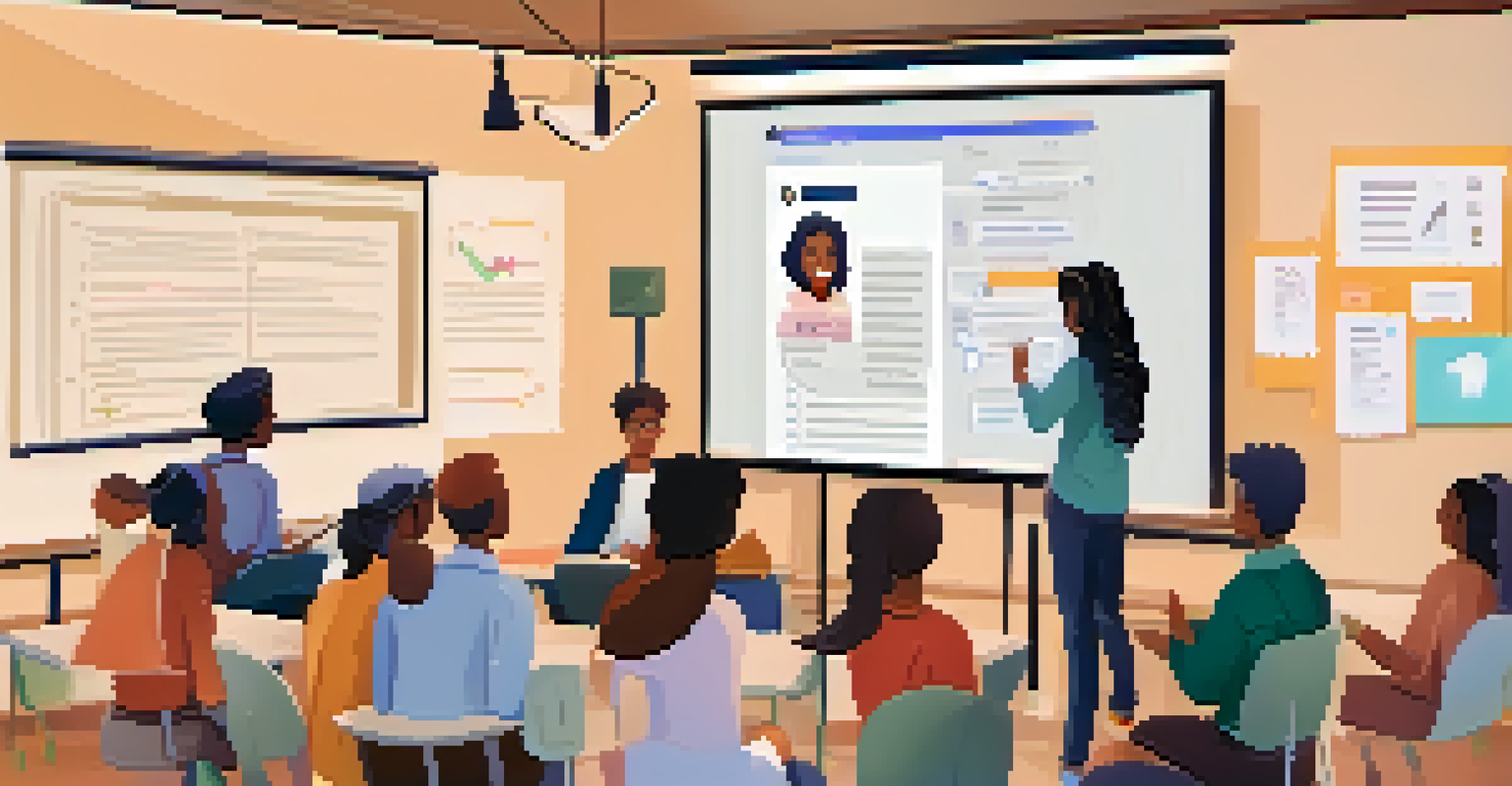Creating Peer-Learning Opportunities in Online Spaces

Understanding Peer Learning in Digital Contexts
Peer learning, in simple terms, involves students learning from each other. In online spaces, this concept can thrive through collaboration and shared experiences. Think of it as a virtual study group where knowledge is exchanged freely, making learning more interactive and engaging.
The greatest gifts you can give your children are the roots of responsibility and the wings of independence.
Unlike traditional learning, peer learning allows participants to explore topics from different perspectives. This diversity enhances understanding and retention, as peers often explain concepts in relatable terms. It's like having a friend break down a complicated topic into digestible bites.
Moreover, with the rise of digital platforms, creating these learning opportunities has never been easier. Virtual classrooms, forums, and collaborative tools can facilitate connections that might not happen in a physical setting. Embracing these tools opens the door for richer educational experiences.
Choosing the Right Online Platforms for Learning
Selecting the right platform is crucial for effective peer learning. Consider user-friendly options that promote interaction, such as discussion boards, social media groups, or dedicated learning management systems. Each platform has unique features that can enhance or hinder the learning experience.

For instance, platforms like Slack or Discord enable real-time conversations, making it easier for peers to engage spontaneously. On the other hand, platforms like Google Docs allow for collaborative document creation, where learners can contribute ideas and feedback simultaneously. The key is to match the platform with your group's needs and learning goals.
Peer Learning Enhances Engagement
Peer learning fosters collaboration and interactive experiences, making the educational process more engaging and effective.
Ultimately, the right platform should encourage participation and foster a sense of community. When learners feel comfortable and connected, they're more likely to share insights and support each other. A well-chosen platform can transform peer learning from a mere idea into a vibrant reality.
Establishing Clear Goals for Peer Learning Sessions
Setting clear goals is essential to make the most of peer learning opportunities. Goals provide direction and purpose, ensuring that all participants understand what they aim to achieve together. Think of these goals as a roadmap that guides the group through the learning journey.
Alone we can do so little; together we can do so much.
For instance, if the focus is on mastering a specific skill, the goal might be to complete a project collaboratively or to prepare for an upcoming exam. These objectives help participants stay engaged and accountable, encouraging active participation and contribution.
Moreover, discussing these goals at the beginning fosters a sense of ownership among group members. When everyone is on the same page, it creates a collective commitment to learning. This shared understanding can significantly enhance motivation and the overall learning experience.
Encouraging Effective Communication Among Peers
Communication is the lifeblood of peer learning, especially in online settings. Encouraging open dialogue helps participants feel valued and heard, which is vital for a successful learning environment. It's essential to create a culture where questions and ideas can flow freely.
One way to foster effective communication is by establishing ground rules for interactions. These might include respectful listening, constructive feedback, and encouraging quieter members to share their thoughts. Just like in a face-to-face setting, clear communication norms can help maintain a positive atmosphere.
Effective Communication is Key
Establishing open dialogue and clear communication norms is essential for creating a positive and productive peer learning environment.
Additionally, leveraging various communication tools can enhance interaction. Video calls, voice messages, and chat options can cater to different preferences, ensuring everyone has a chance to participate. The more comfortable participants feel communicating, the richer the learning experience becomes.
Utilizing Collaborative Projects to Enhance Learning
Collaborative projects are a fantastic way to put peer learning into practice. By working together on assignments, participants can apply their knowledge and learn from one another's strengths. It's like a culinary team where each chef brings a unique ingredient to the dish, resulting in a delightful outcome.
These projects can take various forms—group presentations, research tasks, or creative endeavors—depending on the group's interests and goals. The collaborative aspect not only deepens understanding but also builds teamwork skills that are invaluable in any setting.
Moreover, these projects create opportunities for feedback and reflection, which are crucial for growth. Participants can discuss what worked well and areas for improvement, reinforcing their learning. This cycle of collaboration and feedback transforms peer learning from passive to active engagement.
Fostering a Supportive Learning Environment
Creating a supportive learning environment is key to successful peer learning. Participants should feel safe to express their ideas and make mistakes without fear of judgment. This sense of safety encourages risk-taking, which is essential for deep learning.
One effective way to nurture this environment is by celebrating small wins and acknowledging contributions. Simple gestures, like highlighting a member's insightful comment or progress, can significantly boost morale and encourage continued participation. It's like cheering on a friend during a challenging task—they're more likely to keep going with your support.
Supportive Environments Boost Learning
Creating a safe and supportive atmosphere encourages risk-taking and enhances the overall learning experience among peers.
Additionally, offering resources and guidance can further enhance this supportive atmosphere. Providing access to relevant materials or inviting experts to share their knowledge can empower participants and enrich discussions. A nurturing environment not only promotes learning but also fosters lasting relationships among peers.
Evaluating Peer Learning Outcomes and Success
Evaluating the outcomes of peer learning is crucial to understand its effectiveness and areas for improvement. This process involves reflecting on both individual and group progress, assessing whether the initial goals were met. It's akin to checking the map after a journey to see if you reached your destination.
Feedback from participants can provide valuable insights into what worked well and what didn’t. Surveys, discussions, or informal check-ins can prompt constructive reflections, helping everyone learn from the experience. This feedback loop is essential for continuous growth and adaptation.

Moreover, celebrating achievements, no matter how small, can reinforce the value of peer learning. Recognizing progress fosters motivation and encourages participants to embrace future opportunities. By regularly evaluating outcomes, groups can refine their approach and enhance the overall learning experience.